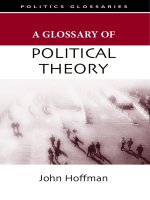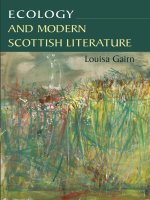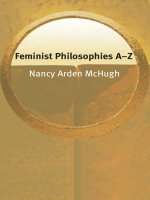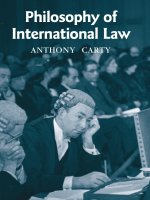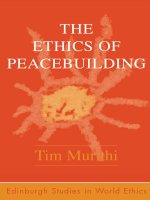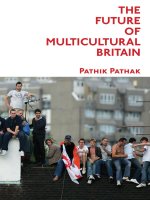edinburgh university press ecology and modern scottish literature may 2008
Bạn đang xem bản rút gọn của tài liệu. Xem và tải ngay bản đầy đủ của tài liệu tại đây (753.43 KB, 209 trang )
Louisa Gairn
‘This is the first book-length study of one of the great themes in modern Scottish writing. Lucid, sophisticated and
internationally-minded, it is a landmark work.’
Robert Crawford, University of St Andrews
‘In this groundbreaking study, Louisa Gairn establishes for the first time the central place of ecological thinking in
the Scottish tradition, from the integrated social vision of Patrick Geddes through MacDiarmid with his ‘earth lyrics’
to contemporary writers like Kathleen Jamie and John Burnside. This is one of those rare critical studies that offers
close readings of great writers while sustaining a clear and tense focus on the immediacy of the world around us.’
Professor Alan Riach, Department of Scottish Literature, University of Glasgow
This book presents a provocative and timely reconsideration of modern Scottish literature in the light of ecological
thought. Louisa Gairn demonstrates how successive generations of Scottish writers have both reflected on and
contributed to the development of international ecological theory and philosophy.
Provocative re-readings of works by authors including Robert Louis Stevenson, John Muir, Nan Shepherd, John
Burnside, Kathleen Jamie and George Mackay Brown demonstrate the significance of ecological thought across
the spectrum of Scottish literary culture. This book traces the influence of ecology as a scientific, philosophical
and political concept in the work of these and other writers and in doing so presents an original outlook on
Scottish literature from the mid-nineteenth century to the present.
In this age of environmental crisis, Ecology and Modern Scottish Literature reveals a heritage of ecological thought
which should be recognised as of vital relevance both to Scottish literary culture and to the wider field of green studies.
Louisa Gairn holds a PhD from the University of St Andrews and is a contributor to The Edinburgh Companion
to Contemporary Scottish Literature, ed. Berthold Schoene (Edinburgh University Press, 2007). She lives and works
in Edinburgh.
ISBN 978 0 7486 3311 1
Cover image: Ripening Barley by Joan Eardley.
Courtesy of The Scottish Gallery. © The Eardley Estate.
Photography by John McKenzie.
Cover design: Cathy Sprent
Edinburgh University Press
22 George Square
Edinburgh EH8 9LF
www.eup.ed.ac.uk
ECOLOGY AND MODERN SCOTTISH LITERATURE
Louisa Gairn
Edinburgh
ECOLOGY
AND MODERN
SCOTTISH LITERATURE
ECOLOGY
AND MODERN
SCOTTISH LITERATURE
Louisa Gairn
Ecology and Modern Scottish Literature
Literature
Louisa Gairn
Edinburgh University Press
© Louisa Gairn, 2008
Edinburgh University Press Ltd
22 George Square, Edinburgh
Typeset in Sabon and Futura
by Servis Filmsetting Ltd, Manchester, and
printed and bound in Great Britain by
Antony Rowe Ltd, Chippenham, Wilts
A CIP record for this book is available from the British Library
ISBN 978 0 7486 3311 1 (hardback)
The right of Louisa Gairn
to be identified as author of this work
has been asserted in accordance with
the Copyright, Designs and Patents Act 1988.
Contents
Acknowledgements vii
List of Figures ix
Introduction: Re-mapping Modern Scottish Literature 1
1 Feelings for Nature in Victorian Scotland 14
2Strange Lands 46
3 Local and Global Outlooks 77
4Dear Green Places 110
5 Lines of Defence 156
Index 192
Most of the research for this book was carried out during my doctoral
studies at the University of St Andrews. Special thanks are due to Robert
Crawford who, as my doctoral supervisor, supplied three years’ worth of
helpful advice and insightful suggestions, and who encouraged me to
embark on postgraduate research in the first place. I am also greatly
indebted to Douglas Dunn and Alan Riach who read and commented on
the text, and who, together with Michael Gardiner, encouraged me to
seek publication. I would also like to thank Jackie Jones and her col-
leagues at Edinburgh University Press for good advice, support and
patience. My thinking on philosophical and ecocritical matters and on the
history of the Scottish landscape has been enriched through conversations
with John Burnside, Tom Bristow, Christopher Smout and Christopher
MacLachlan. Thanks also to Fiona Benson, Neil Rhodes, Jill Gamble and
colleagues in the School of English at St Andrews University, and Brian
Johnstone, Anna Crowe and colleagues associated with the StAnza Poetry
Festival. At the University of Edinburgh, I thank Susan Manning and
Vicki Bruce. I am also grateful to Debbie Baird, Stacy Boldrick, Sue
Coleman, Anne Sofie Laegran, Veronica Kessenich and David Wolfenden
for much appreciated moral support.
This book would not have been possible without the generosity of the
Carnegie Trust for the Universities of Scotland and the Caledonian
Research Foundation, who funded my doctoral studies. The always
helpful staff of St Andrews University Library, the University of
Edinburgh Library and the National Library of Scotland have greatly
aided my research, as have the Scottish Rights of Way Association, and
the Scottish Geographical Society, with whose kind permission the
remarkable illustrations for Patrick Geddes’s ‘Draft Plan for a National
Institute of Geography’ are reproduced. Some of the ideas on Edwin
Muir and Edwin Morgan in Chapter 4 and Kathleen Jamie in Chapter
5 are also explored in my essays published in David James and Philip
Tew (eds), New Versions of Pastoral (Fairleigh Dickinson, in press) and
Berthold Schoene (ed.), The Edinburgh Companion to Contemporary
Scottish Literature (Edinburgh University Press, 2007).
I would like to put in a special word of thanks to Johan Kildal, whose
friendship and affection have helped me through the writing process.
Most of all, I thank my parents, James and Margaret Gairn, whose con-
stant support and encouragement have sustained me throughout this
project. This book is dedicated to them, with love.
Louisa Gairn
Edinburgh, August 2007
viii
Acknowledgements
List of Illustrations
Figure 1 Patrick Geddes and M. Galeron, ‘Suggested Plan for a
National Institute of Geography’, The Scottish Geographical
Magazine, vol. XVIII (1902).
Figure 2 Detail, Patrick Geddes and M. Galeron, ‘Suggested Plan for a
National Institute of Geography’, The Scottish Geographical
Magazine, vol. XVIII (1902).
Reproduced with permission from the Scottish Geographical Society.
Scottish Literature
Knowing the how, and celebrating the that, it seems to me, is the basis of
meaningful dwelling: what interests me about ecology and poetry is that,
together, they make up a science of belonging, a discipline by which we may
both describe and celebrate the ‘everything that is the case’ of the world, and
so become worthy participants in a natural history.
1
John Burnside
Biodiversity, whether vegetal, animal, human, geophysical, or astrophysical,
is surely the key.
2
Edwin Morgan
Certain gardens are described as retreats when they are really attacks.
3
Ian
Hamilton Finlay
This book suggests that the science and philosophy of ecology, which
asks questions about being in the world, about ‘dwelling’ and ‘belong-
ing’, and most fundamentally, about the relationship between humans
and the natural environment, has been a valuable and significant
concept in the work of Scottish writers since the mid-nineteenth century.
When the Grampian novelist Nan Shepherd wrote that ‘Knowledge does
not dispel mystery’, ‘the more one learns of this intricate interplay of
soil, altitude, weather, and the living tissues of plant and insect . . . the
more the mystery deepens’, she picked up on an important idea which
has been recognised more recently by John Burnside, whose work
speaks of an attempt to fuse ecology and poetry to produce ‘a science of
belonging’.
4
This book suggests that writing about the natural world is
a vital component of a diverse Scottish literature, and demonstrates how
successive generations of Scottish writers have both reflected and con-
tributed to the development of international ecological theory and phi-
losophy. In doing so, this is both a book about Scottish literature from
the perspective of ecological thought, and a consideration of the devel-
opment of ecological and ecocritical traditions and discourses since the
mid-nineteenth century.
Kenneth White, the poet and theorist of ‘geopoetics’, has argued
for the need to extend the ‘referential topography’ of Scottish culture
through ‘a new grounding’, the establishment of ‘a new relationship’
with nature (and specifically with Scottish ‘wilderness country’), which
is fundamentally distinct from the ‘rural bucolics’ of the English tradi-
tion.
5
The environmental historian T. C. Smout echoes White in sug-
gesting the validity of a ‘special Scottish context for the study of
ecology’, a distinctively Scottish tradition developed by the ecological
thinker and cultural protagonist Patrick Geddes in the late nineteenth
and early twentieth centuries, ‘remarkable as seeing man as a prime
actor among other animals, instead of searching for a “natural” world
uninvaded by man, which was more characteristic of ecology in the
south of Britain’.
6
The recognition that humans are part of the world of
nature, affecting and affected by it, is central to modern global envi-
ronmental consciousness. However, it also has important implications
for local environments, highlighting, for example, the danger of viewing
rural areas such as the Scottish Highlands as untouched ‘wild’ land-
scapes, a playground without a history.
7
The Scottish writers considered
in this book are particularly sensitive to such concerns; fascinated, as
Robert Louis Stevenson was, by the echoes of the ‘primitive wayfarers’
of the past.
8
For Sorley Maclean, the resonances of Gaelic community
lingered in the wooded landscape of Raasay, while the ancestral ‘folk’
of the Mearns in Lewis Grassic Gibbon’s fiction are a presence ‘so
tenuous and yet so real’.
9
To ignore the history of human inhabitation
in the rural environments of Scotland, Kathleen Jamie suggests, ‘seems
an affront to those many generations who took their living on that
land . . . they left such subtle marks’.
10
While we need to be cautious of
an overly anthropocentric outlook on the natural world, for Jamie and
Burnside as for previous generations of Scottish writers and theorists
from Geddes to George Mackay Brown, we must also acknowledge
those ‘subtle marks’ in order to make sense of our own relationship to
the earth; to gain a meaningful sense of ourselves as ‘participants in a
natural history’.
Recent Scottish criticism has spoken of an ‘urgent need to approach
Scottish texts from a range of different and complementary perspectives’,
and to recognise Scottish writers’ engagement with and contribution to
critical theory.
11
By asserting the importance of ecological concerns in
Scottish writing, this book seeks to re-map Scottish literary culture
according to a thematic perspective which has often been thought of as
marginal to modern society. Ecology and Modern Scottish Literature
demonstrates that ecologically-aware criticism is a potentially liberating
influence on the study of Scottish literature, placing it within a field of
enquiry that is of global relevance. At the same time, this ecological view-
point reveals meaningful interconnections between Scottish writers not
2
Ecology and Modern Scottish Literature
always considered together, challenging, for example, the assumption
that there is a fundamental division between urban and rural perspec-
tives in modern Scotland. The facile categorisation of Scottish literature
into the critical themes of ‘tartanry, Kailyard and latterly Clydeside-ism’
has been attacked by critics such as Adrienne Scullion, who contends that
such restrictive perspectives obscure the subtleties and the complexity of
Scottish writing.
12
While those reductive categories are being eroded, the
supposed rift between ‘rural’ and ‘urban’ literature remains, encourag-
ing a distorted outlook on Scottish literature: either writers are indulging
in sub-Romantic escapism or they are exposing brutal realities – a
dichotomy which Douglas Dunn has, with tongue in cheek, identified as
one of ‘Romantic Sleep’ versus ‘Social Responsibility’.
13
The truth is that
the situation is not so black and white – nor so green and red. Jamie states
that ‘I take my solace in the natural world . . . my local landscape, the
energy of the land’, although she admits ‘Being in the thick of it rather
prevents one from wandering lonely as a cloud’.
14
I would like to suggest
that writing which considers our relationship to the natural world need
not be some sort of avoidance tactic, but can bring both writer and
reader back to ‘being-in-the-world’, understanding what it means to be
‘in the thick of it’.
Since the potential range of its subject is vast, Ecology and Modern
Scottish Literature is not intended to be an exhaustive survey; the
writers discussed have been selected for their literary significance and for
the interesting and often unexpected ways in which ecological ideas are
reflected or examined in their work. This has meant that certain authors
have received less attention than might be expected. Naomi Mitchison
and Norman MacCaig might seem obvious candidates for an ecologi-
cally-minded outlook on Scottish literature, while figures such as Hugh
MacDiarmid, Alan Warner and Edwin Morgan, who have received sig-
nificant attention in the present study, may seem surprising choices. The
intention here is to challenge preconceptions about Scottish literature
and the natural world, and in doing so, offer some provocative re-read-
ings of writers across the spectrum of Scottish literary culture. This
approach demonstrates how ‘canonical’ writers like Robert Louis
Stevenson and Hugh MacDiarmid can continue to be read in new ways,
and how urban writers such as Archie Hind have a relevance to debates
over rural and environmental issues which is rarely acknowledged.
Equally importantly, this ecological viewpoint sets apparently ‘mar-
ginal’ rural writers like Nan Shepherd, Ian Hamilton Finlay and George
Mackay Brown firmly at the centre of Scottish literary culture, showing
how their work connects with international ecological theories and
debates.
Introduction
3
Ecology and Modern Scottish Literature quite deliberately begins in
the mid-nineteenth century, past the height of the Romantic period, and
at a time when the environmental sciences were being formed into dis-
tinctive and provocative new discourses about the relationship between
humans and the natural world.
15
There are, certainly, distinctive pre-
cursors to modern ecological awareness in Scottish literary culture, and
it is important to acknowledge the significance of earlier writers, par-
ticularly those writers of the late eighteenth and early nineteenth cen-
turies who might broadly be termed ‘Romantic’ – James Macpherson,
Walter Scott, James Hogg and Robert Burns – and, equally importantly,
poets from the Gaelic tradition such as Dunan Ban MacIntyre. In his
landmark work of British ecocriticism, The Song of the Earth (2000),
Jonathan Bate suggests that William Wordsworth ‘could not have
known that one effect of his writing on the consciousness of later readers
would have been the establishment of a network of National Parks, first
in the United States and then in Britain’.
16
But it was not Wordsworth’s,
but Burns’s poems that John Muir, the Scots-born founder of the
National Parks movement in the United States, carried with him on his
wilderness walks.
17
Burns’s essentially democratic approach appealed to
Muir, who valued his sense of sympathy between the human and natural
worlds, the acknowledgement of ‘the essential oneness of all living
beings’, the ‘kinship of God’s creatures . . . [as] earth-born companions
and fellow mortals’.
18
Scott has been similarly influential. While, at
times, he has been criticised for eclipsing the geopolitical realities of the
Highlands in favour of what some critics have termed ‘romantic illu-
sions’, Scott’s centrality to the Romantic tradition alone merits consid-
eration from the perspective of ecology.
19
Shades of Scott’s wonder at
the ‘wild and precipitous . . . heathy and savage’ Highland landscapes
of Waverley (1814), and the Romantic national sentiment of the
‘Caledonia! Stern and wild’ variety, can be traced in Muir’s evocation of
the ‘stern, immovable majesty’ of Yosemite.
20
Muir’s National Parks
were, like Scott’s Highlands, also lands of ‘the shaggy wood . . . the
mountain and the flood’, although Muir, post-Darwin and writing with
the knowledge of the new earth sciences, finds a heightened sense of
wonder as he pauses to consider how ‘the crystal rock[s] were brought
to light by glaciers made up of crystal snow’, the result of the ‘sublime
ice-floods of the glacial period’.
21
While Romanticism undoubtedly continued, and continues, to be
influential, realisations of its limitations have provoked varied responses
in the formation of modern Scottish writers’ models of attentiveness,
observation and representation. ‘Why did Wordsworth bury his head in
an illusory intuition into the message of hills or hedge-rows?’ asked
4
Ecology and Modern Scottish Literature
Sorley Maclean in 1938.
22
Looking back to traditions in Gaelic poetry,
and writers like Duncan Ban MacIntyre, Maclean argued for the impor-
tance of descriptive ‘realism’ suffused with genuine emotion, in contrast
to what he saw as escapist Romantic ideologies, whose emotions were
fundamentally inauthentic responses, ‘mere fancifulness, day-dreaming,
wish-fulfilment, or weak sentimentality’. For Maclean, Gaelic poetry’s
‘realisation of dynamic nature’ carries a greater philosophical signifi-
cance than English Romanticism.
23
While this is a polemic from a writer
conscious of the need to assert Gaelic distinctiveness in the face of the
dominant English canon, Maclean’s approach suggests a new perspec-
tive on ‘nature writing’, a way of relating to the natural world which cri-
tiques anthropocentric or unreflective Romantic responses, and accords
a greater significance to physical experience, to being ‘in the thick of it’.
The possibility of a new form of poetry which can ‘realise’ the natural
world – to ‘get into this stone world’ as MacDiarmid said in ‘On a
Raised Beach’ (1934) – is something which has proved central to post-
war Scottish poetics.
24
The contemplation of how best to express the
‘real’, explored in the post-war work of Gunn, MacDiarmid and Iain
Crichton Smith, finds varied expression in Ian Hamilton Finlay’s con-
crete poetry, White’s way books, and Mackay Brown’s lyrics, and more
recently in the poetry and prose of Burnside and Jamie, writers who are
consciously setting out to explore constructions of ‘self’ and ‘other’ in
the context of ecological theory. Modern Scottish views of ‘ecology’ are
not simply the appropriation of Romantic discourses but are attempts
to find new ways of thinking about, representing and relating to the
natural world.
Whilst ecological values and concepts have a history which pre-dates
the official formulation of ‘ecology’ as a science, it makes sense to begin
with the 1866 definition of ‘öekologie’ as explained by the inventor of
the term, the German biologist Ernst Haeckel, as ‘the body of knowl-
edge concerning the economy of nature . . . the study of all those
complex interrelations referred to by Darwin as the conditions of the
struggle for existence’.
25
Literally meaning ‘house study’, ecology
started off as a biological science, a new way of looking at ‘natural
history’ which took its cue from Darwinian evolutionary theory and, as
the scientific historian Peter Bowler observes, initially it had ‘no clear-
cut links to the environmental movement’.
26
The eco-critic Neil
Evernden points out that ecology ‘begins as a normal, reductionist
science’, but ‘to its own surprise it winds up denying the subject-object
relationship upon which science rests’.
27
The concept of interrelations between organism and environment,
and indeed the breakdown of the categories of ‘self’ and ‘other’ which
Introduction
5
have followed in the light of that central idea, is what makes ecological
thought so attractive to many modern thinkers and writers. The resolu-
tion of dualistic categories allows an escape route from the old Cartesian
hierarchies which have defined Western thought for so long: self/other,
culture/nature, mind/body. Descartes, and the tradition of scientific
authority which followed in his wake, is often blamed by eco-theorists
as the source of Western civilisation’s perceived alienation from the
world of nature, where the ‘Cartesian distinction between the res cogi-
tans, or thinking self, and the res extensa, or embodied substance, sets
up the terms for the objectivity of science and the abstraction from his-
toricity, location, nature, and culture’.
28
Scottish thinkers such as Patrick Geddes recognised early on that
there was an ecological interrelationship among individual, community
and environment, heralding ‘the change from the mechanocentric view
and treatment of nature and her processes to a more and more fully bio-
centric one’.
29
Writing in 1898, Geddes suggests that our understanding
of the world is enriched by a combination of scientific knowledge with
a complementary focus on ‘sight, emotion, experience . . . odour, taste
and memory’.
30
In similar vein, phenomenological philosophy asserts
the importance of ‘lived experience’ and suggests that ‘it is the body, and
it alone . . . that can bring us to the things themselves’.
31
Indeed, the
rigid categories suggested by Cartesian philosophy are difficult to main-
tain in the face of new evidence that, for example, human perception
occurs at the point of interface with the environment, rather than by the
internal processing of external stimuli, or that the human body itself is
permeable, part of its environment rather than a discrete entity.
32
The
new perspectives afforded by ecological thought suggest a new ‘concep-
tion of the human being not as a composite entity made up of separable
but complementary parts, such as body, mind and culture, but rather as
a singular locus of creative growth within a continually unfolding field
of relationships’.
33
Ecological discourses thus not only highlight impor-
tant environmental concerns; they allow for the growth of a new sense
of self, and of the relationship between self and other, which radically
differs from what has gone before. One might begin to think of this
newly configured relationship between humans and the environment as
one of osmosis rather than consumption; with this knowledge, the atten-
tive, semi-permeable, ‘natural’ self might find it difficult to think of its
environment as a functional resource, ready to be exploited.
In parallel with such ecocritical and philosophical considerations,
modern environmental science has radically changed our way of think-
ing about both our local environments and the earth as a whole.
‘Nature’ is no longer viewed as a stable system of useful commodities or
6
Ecology and Modern Scottish Literature
as an immutable backdrop to human life, but as a fragile system which
human actions can and do modify, pollute or even destroy. The
American naturalist Rachel Carson helped to popularise the environ-
mental cause with the publication of Silent Spring in 1962, a book about
the devastating effects of agricultural pesticides on ecosystems in the
USA, whilst James Lovelock’s ‘Gaia hypothesis’ did much to bring holis-
tic ecological concepts to a wider audience, with his book, Gaia: A New
Look at Life on Earth (1974). Lovelock’s hypothesis was that earth is ‘a
superorganism composed of all life tightly coupled with the air, the
oceans, and the surface rocks’ – a holistic idea which, as Lovelock
acknowledges, was perhaps first voiced by the Scottish ‘father of
geology’, James Hutton, in 1785.
34
Attitudes to nature within cultural studies have, however, sometimes
tended towards the abstract side of post-structuralism, viewing nature
as a ‘societal category’ or a ‘linguistic construct’ rather than a discrete
entity. Jean Baudrillard is perhaps representative of this sort of view; in
his travels across the American desert he saw, instead of natural geo-
logical features, a landscape of ‘signs’; Monument Valley as ‘blocks of
language . . . destined to become, like all that is cultivated – like all
culture – natural parks’.
35
Jonathan Bate says he started ‘doing ecolog-
ical literary criticism’ when he ‘grew impatient with a tendency
among the most advanced readers of William Wordsworth to claim that
there is “no such thing as nature” ’.
36
An ‘ecological criticism’, Karl
Kroeber suggests, escapes ‘from the esoteric abstractness that afflicts
current theorising about literature’ and ‘seizes opportunities offered by
recent biological research to make humanistic studies more socially
responsible’, resisting ‘academic overemphasis on the rationalistic at
the expense of sensory, emotional, and imaginative aspects of art’.
37
A
variety of definitions of these new perspectives have emerged, but
Cheryl Glotfelty’s summary is perhaps the most straightforward,
stating that ‘all ecological criticism shares the fundamental premise that
human culture is connected to the physical world, affecting it and
affected by it . . . as a theoretical discourse, it negotiates between the
human and the nonhuman’. While in most postmodern theory, ‘the
world’ denotes the anthropocentric sphere of language and culture,
ecological criticism ‘expands “the world” to include the entire ecos-
phere’.
38
Bate takes up this approach by developing his theory of
‘ecopoetics’, asserting ‘the capacity of the writer to restore us to the
earth which is our home’ through writing which acknowledges that
‘although we make sense of things by way of words, we do not live
apart from the world. For culture and environment are held together in
a complex and delicate web’.
39
Introduction
7
Despite White’s call for a ‘new grounding’, there have been few
overtly ‘ecocritical’ approaches to Scottish literature.
40
Instead, it is
Scotland’s creative writers who have led the way in developing such per-
spectives in their own work and on other Scottish writing. In his essays
and editorial work, John Burnside has been developing an ecophilo-
sophical approach related to, but distinct from, Bate’s The Song of the
Earth (2000). Perhaps more significantly, Kenneth White’s ‘geopoetics’,
a doctrine of ‘contact between the human mind and the things, the lines,
the rhythms of the earth’, having crystallised in the establishment of the
International Institute of Geopoetics in 1989, forms its own distinctive
critical categories and predates Bate’s ‘ecopoetics’ by more than a
decade.
41
Related questions have, however, been percolating into Scottish
cultural studies for some years. In accordance with critical responses
provoked by the 1970s and 80s turn to place or ‘territory’, represented,
for example, by Seamus Heaney’s poetry and his influential essay,
‘The Sense of Place’, there has been a growing critical awareness of
the importance of location and environment in shaping Scottish
writing.
42
Concurrent with this, critics have begun to acknowledge the
significance of rural or ‘provincial’ locations in the personal and artistic
development of key Scottish writers such as Hugh MacDiarmid.
43
Considerations of Scottish novelistic ‘regionalism’, despite the
parochialising connotations that term sometimes evokes, have also
been a significant proportion of the output of Scottish literary criti-
cism over the past decades.
44
The late twentieth-century critical ‘redis-
covery’ of certain rural novels, such as George Douglas Brown’s
The House with the Green Shutters (1901), combined with reassess-
ments of the nineteenth-century ‘Kailyard’ school by Ian Campbell and
others, has helped to foster an awareness of questions about the ade-
quacy of certain representations of Scotland’s rural environments.
45
Historians of Scotland’s environment, such as T. C. Smout and Robert
Lambert, have helped to add ecology to a field which has until recently
been dominated by questions of nationalist politics, cultural identity and
socio-economic factors.
46
Such publications demonstrate how a variety
of disciplines are beginning to recognise the importance of ecological
thought, that, as Burnside contends, we are all ‘participants in a natural
history’. They also demonstrate how far traditional divisions between
the humanities and sciences are being bridged by new interdisciplinary,
ecologically-aware perspectives – a crucial concern running through
Scottish literary culture from Geddes and MacDiarmid to White and
Burnside: the need for ‘completeness of thought | A synthesis of all view-
points’.
47
8
Ecology and Modern Scottish Literature
The proliferation of such outlooks also reflects the growing public
and political awareness of environmental issues, in Scotland and else-
where. Whilst at the height of the industrial era, societal attitudes to the
environment were of relatively little concern to legislators, in post-
industrial Scotland, coverage of ecological matters in the Scottish press
has brought questions of land use and ownership, ‘sustainability’,
wildlife protection and conservation to the fore. There is now a wide-
spread recognition that Scotland’s natural environment is both valuable
and fragile, and can no longer be viewed as an inexhaustible resource
for human industry. The current debates over renewable sources of
energy, such as wind farming or wave power, demonstrate just how
‘mainstream’ ecological questions have become in Scotland, and how
global issues such as climate change are related in the public and leg-
islative consciousness to specific, local concerns over land use and envi-
ronmental impact.
Reflecting these broad theoretical and political questions, Ecology
and Modern Scottish Literature follows a generally historical trajectory,
tracing thematic connections within Scottish writing and setting these in
relation to international ecological discourses. Chapter 1 considers the
writings of Robert Louis Stevenson alongside those of nineteenth-
century mountaineering intellectuals John Veitch and John Stuart
Blackie, land rights campaigners and the poetry of Gaelic crofters,
which, taken together demonstrate a crucial shift towards a more bodily
experience of the natural world, a new ‘feeling for nature’ spurred by
developments in biological science which offered fresh perspectives on
the relationship between self and world. Taking up the idea of ‘exile’ in
the context of the philosophy of ‘dwelling’ developed by ecotheorists,
Chapter 2 explores the confrontation of modernity and wilderness in
Stevenson’s fiction and travel writings, relating this to the work of John
Muir and to ideas developed by Henry David Thoreau, Walt Whitman
and Charles Baudelaire. The development of ecologically-sensitive local
and global perspectives in the work of Hugh MacDiarmid, Lewis
Grassic Gibbon and others in the inter-war years, was, as Chapter 3
reveals, a reflection of the ‘cosmic and regional’ perspectives fostered by
Patrick Geddes and other early twentieth-century ecological thinkers.
Questions of the local and global become ever more significant in the
post-war period, considered in the ‘dear green places’ of Chapter 4,
which contends that post-war ‘rural’ writers including Nan Shepherd,
Neil Gunn, Edwin Muir and George Mackay Brown, often viewed as
peripheral, are actually central and of international relevance, and ques-
tions the supposed division between Scottish rural and urban writing.
The search for ways of encountering and expressing the non-human
Introduction
9
world through poetry is central to the later work of Hugh MacDiarmid
and to the geopoetic practice of Kenneth White, while the poetry and
prose of Ian Hamilton Finlay, Iain Crichton Smith and George Mackay
Brown constitute a crucial element of resistance in the face of environ-
mental and cultural degradation. As we move into the twenty-first
century, such ‘lines of defence’ become more explicit in Scottish writing.
Chapter 5 demonstrates that John Burnside, Kathleen Jamie and Alan
Warner are not only reviewing human relationships with nature, but
also the role writing has to play in exploring and strengthening that rela-
tionship, helping to determine the ecological ‘value’ of poetry and
fiction.
If what emerges is not exactly a ‘tradition’, perhaps it is related to
what the anthropologist and ecotheorist Tim Ingold has described as
an ‘education of attention’, something Kathleen Jamie calls the mainte-
nance of ‘the web of our noticing, a way of being in the world’.
48
What each generation contributes to the next . . . is an education of atten-
tion Through this fine-tuning of perceptual skills, meanings immanent in
the environment – that is in the relational contexts of the perceiver’s involve-
ment in the world – are not so much constructed as discovered.
49
All writing, one might suggest, involves this ‘fine-tuning of perceptual
skills’. Scottish writers in particular have been sensitive to the perceived
erosion of links between language, traditional culture and the natural
world; the need to enact gestures of reconnection and reconciliation. As
we move into an era ever more preoccupied with mass consumerism and
globalisation on the one hand, and the looming threat of environmen-
tal degradation, even devastation, on the other, the search for a place
where ‘function and form, beauty and objective fact, the laws of nature
and a sense of mystery can coexist’ becomes ever more vital.
50
This book
suggests that such a synthesis of viewpoints has in fact been present in
Scottish literature all along, characterised by a quality of lyrical atten-
tiveness, which in many ways fulfils Burnside’s criteria for a ‘science of
belonging’ or Bate’s definition of ‘ecopoetics’. From the theories of land-
scape and writing developed by Robert Louis Stevenson and his moun-
taineering contemporaries, to Patrick Geddes’s biocentrism, Nan
Shepherd’s Living Mountain or the philosophy of dwelling and belong-
ing explored by Edwin Muir, Scottish writers have been engaging with
the science and philosophy of ecology since its inception. Modern
Scottish literature constitutes a distinctive heritage of ecological thought
which is both vitally relevant to international environmentalism and
central to Scottish culture.
10
Ecology and Modern Scottish Literature
Notes
1. John Burnside, ‘A Science of Belonging: Poetry as Ecology’, in Robert
Crawford (ed.), Contemporary Poetry and Contemporary Science
(Oxford: Oxford University Press, 2006), p. 92.
2. Edwin Morgan, ‘Roof of Fireflies’, in W. N. Herbert and Matthew Hollis
(eds), Strong Words: modern poets on modern poetry (Tarset,
Northumberland: Bloodaxe Books, 2000), p. 192.
3. Ian Hamilton Finlay, ‘Unconnected Sentences on Gardening’, in Yves
Abrioux, Ian Hamilton Finlay, A Visual Primer (Edinburgh: Reaktion
Books, 1985), p. 40.
4. Nan Shepherd, The Living Mountain in Roderick Watson (ed.), The
Grampian Quartet (Edinburgh: Canongate, 1996), p. 45.
5. Kenneth White, ‘The Alban Project’, On Scottish Ground: Selected Essays
(Edinburgh: Polygon, 1998), pp. 13–14.
6. T. C. Smout, ‘The Highlands and the Roots of Green Consciousness, 1750–
1990’, Proceedings of the British Academy 76 (1991), pp. 240–1.
7. The concept of the Scottish ‘adventure playground’ is discussed in
Christopher MacLachlan, ‘Nature in Scottish Literature’, in Patrick D.
Murphy (ed.), Literature of Nature: An International Sourcebook
(Chicago and London: Fitzroy Dearborn Publishers, 1998), pp. 184–90.
8. Robert Louis Stevenson, ‘Roads’, Essays of Travel (London: Chatto &
Windus, 1916), p. 216.
9. Stevenson, ‘Roads’, Essays of Travel p. 216; Lewis Grassic Gibbon, ‘The
Land’ in Valentina Bold (ed.), Smeddum: A Lewis Grassic Gibbon
Anthology (Edinburgh: Canongate Classics, 2001), pp. 90–1.
10. Kathleen Jamie, Findings (London: Sort of Books, 2005), p. 126.
11. Christopher Whyte, Modern Scottish Poetry (Edinburgh: Edinburgh
University Press, 2004), pp. 8–9; Michael Gardiner, From Trocchi to
Trainspotting: Scottish Critical Theory since 1960 (Edinburgh: Edinburgh
University Press, 2006).
12. Adrienne Scullion, ‘Feminine Pleasures and Masculine Indignities: Gender
and Community in Scottish Drama’, Gendering the Nation: Studies in
Scottish Literature (Edinburgh: Edinburgh University Press, 1995), p. 202.
13. Douglas Dunn, quoted in Sean O’Brien, The Deregulated Muse
(Northumberland: Bloodaxe Books, 1998), p. 65.
14. Kathleen Jamie, quoted in Clare Brown and Don Paterson (eds), Don’t Ask
Me What I Mean: Poets in their own words (London: Picador, 2003),
p. 125; 127.
15. Charles Darwin’s On the Origin of Species was first published in 1859;
the Scottish psychologist Alexander Bain’s The Senses and the Intellect
appeared in 1855; the term ‘ecology’ first appeared in Ernst Haeckel’s
Generelle Morphologie (1866).
16. Jonathan Bate, The Song of the Earth (London: Picador, 2000), p. 23.
17. John Muir, A Thousand Mile Walk to the Gulf, in Terry Gifford (ed.),
The Eight Wilderness Discovery Books (London: Diadem Books, 1992),
p. 124.
18. John Muir, ‘Thoughts on the Birthday of Robert Burns’, cited by Graham
White in, The Wilderness Journeys (Edinburgh: Canongate, 1996), p. xviii.
Introduction
11
19. Cairns Craig, The Modern Scottish Novel: Narrative and the National
Imagination (Edinburgh: Edinburgh University Press, 1999), p. 117.
20. Walter Scott, Waverley (London: Penguin, 1972), pp. 144–5; Walter Scott,
‘The Lay of the Last Minstrel’, in James Reed (ed.), Selected Poems,
(London: Routledge, 2003), p. 47; John Muir, ‘The Yosemite’, in Terry
Gifford (ed.), The Eight Wilderness Discovery Books (London: Diadem
Books, 1992), p. 615.
21. Muir, ‘The Yosemite’, p. 680.
22. Sorley Maclean, ‘Realism in Gaelic Poetry’, Ris a’ bhruthaich: criticism and
prose writings (Stornoway: Acair, 1985), p. 19.
23. Ibid. pp. 16–17; p. 34
24. Hugh MacDiarmid, ‘On a Raised Beach’, Complete Poems, Vol. I,
pp. 422–33; p. 429.
25. Ernst Haeckel, quoted by Jonathan Bate in Romantic Ecology: Wordsworth
and the Environmental Tradition (London: Routledge, 1991), p. 36
26. Peter J. Bowler, The Norton History of the Environmental Sciences
(New York: W.W. Norton and Co., 1992), p. 377.
27. Neil Evernden, ‘Beyond Ecology: Self, Place, and the Pathetic Fallacy’, in
Cheryll Glotfelty and Harold Fromm (eds), The Ecocriticism Reader:
Landmarks in Literary Ecology (Athens, GA: University of Georgia Press,
1996), pp. 92–104; p. 93.
28. Michael Serres, quoted by Jonathan Bate in The Song of the Earth
(London: Picador, 2000), p. 87.
29. Lewis Mumford, cited in Ramachandra Guha, ‘Lewis Mumford, the
Forgotten American Environmentalist’, in David Macauley (ed.), Minding
Nature: The Philosophers of Ecology (New York: Guilford Press, 1996),
p. 211.
30. Patrick Geddes, ‘Notes for an Introductory Course of Geography given at
University College Dundee’ (Spring 1898), Geddes Papers, National
Library of Scotland, MS 10619.
31. Maurice Merleau-Ponty, in Thomas Baldwin (ed.), Basic Writings
(London: Routledge, 2004), p. 253.
32. Andy Clark, Being There: Putting Brain, Body, and World Together Again
(Cambridge, MA: MIT Press, 1997), and Tim Ingold, The Perception of the
Environment: Essays in Livelihood, Dwelling and Skill (London:
Routledge, 2000), pp. 1–7.
33. Tim Ingold, The Perception of the Environment: Essays in Livelihood,
Dwelling and Skill (London: Routledge, 2000), pp. 4–5.
34. Hutton said ‘I consider the earth to be a superorganism, and its proper
study is by physiology’. Quoted in James Lovelock, Gaia: A New Look at
Life on Earth (Oxford: Oxford University Press, 1995), p. xvii.
35. Jean Baudrillard, America, trans. Chris Turner (London: Verso, 1986), p. 4.
36. Jonathan Bate, ‘Out of the twilight’, New Statesman, 16 July 2001, v.130
i.4546, p. 25
37. Karl Kroeber, Ecological Literary Criticism: Romantic Imagining and the
Biology of Mind (New York: Columbia University Press, 1994), pp. 1–2.
38. Cheryl Glotfelty, ‘Introduction’, in Cheryl Glotfelty and Harold Fromm
(eds), The Ecocriticism Reader: Landmarks in Literary Ecology (Athens,
GA: University of Georgia Press, 1996), p. xix.
12
Ecology and Modern Scottish Literature
39. Bate, The Song of the Earth, p. ix; p. 23.
40. MacLachlan, ‘Nature in Scottish Literature’.
41. Kenneth White, cited in Tony McManus, ‘Kenneth White: a Transcendental
Scot’, in Gavin Bowd, Charles Forsdick and Norman Bissell, Grounding
aWorld: Essays on the Work of Kenneth White (Glasgow: Alba, 2005),
p. 17. The International Institute of Geopoetics was founded in 1989 at
Trébeurden in France.
42. Seamus Heaney, ‘The Sense of Place’, in Preoccupations: Selected Prose,
1968–1978 (London: Faber, 1980). Critical studies which consider the rela-
tionship between writers and localities include Robert Crawford Identifying
Poets: Self and Territory in Twentieth-Century Poetry (Edinburgh:
Edinburgh University Press, 1993).
43. Robert Crawford, Devolving English Literature (Edinburgh: Edinburgh
University Press, 2000) and Scott Lyall, Hugh MacDiarmid’s Poetry and
Politics of Place: Imagining a Scottish Republic (Edinburgh: Edinburgh
University Press, 2006).
44. Douglas Gifford, Neil M. Gunn and Lewis Grassic Gibbon (Edinburgh:
Oliver and Boyd, 1983).
45. Ian Campbell, Kailyard (Edinburgh: Ramsay Head Press, 1981).
46. Robert A. Lambert, Species History in Scotland: Introductions and
Extinctions Since the Ice Age (Edinburgh: Scottish Cultural Press, 1998);
T. C. Smout, Nature Contested: Environmental History in Scotland and
Northern Ireland since 1600 (Edinburgh: Edinburgh University Press,
2000).
47. Hugh MacDiarmid, ‘In Memoriam James Joyce’, in Complete Poems,
vol. I, p. 802.
48. Kathleen Jamie, ‘Diary’, London Review of Books, vol. 24, no. 11 (6
th
June
2002), p. 39
49. Ingold, The Perception of the Environment, p. 22.
50. John Burnside and Maurice Riordan, ‘Introduction’, in J. Burnside and
M. Riordan (eds), Wild Reckoning: an anthology provoked by Rachel
Carson’s Silent Spring (London: Calouste Gulbenkian Foundation, 2004),
p. 14.
Introduction
13
Chapter1
Feelings for Nature in Victorian
Scotland
We shall need to reawaken our experience of the world as it appears to us in
so far as we are in the world through our body, and in so far as we perceive
the world with our body . . . by this remaking contact with the body and the
world, we shall also rediscover ourself, since, perceiving as we do with our
body, the body is a natural self and, as it were, the subject of perception.
1
Maurice Merleau-Ponty
Mind, body, environment – and poetry
The Scottish scientist Alexander Bain described his groundbreaking psy-
chological treatise, The Senses and the Intellect, published just four years
before Charles Darwin’s On the Origin of Species (1859), as a ‘first
attempt to construct a natural history of the feelings’.
2
‘Feeling’, in the
Romantic period, had come to be associated with the emotions evoked by
aesthetic or sentimental subjects, famously characterised by Henry
MacKenzie’s The Man of Feeling (1771), or the contemplation of the pic-
turesque or the sublime in novels such as Walter Scott’s Waverley (1814)
or in the poetry of William Wordsworth. However, Bain’s scientific
approach to sensation and perception is remarkable in its emphasis
on bodily movement, and its novel way of thinking about experiences
which had, until then, been largely the preserve of the Romantic poet.
Contending that ‘action is a more intimate and inseparable property of our
constitution than any of our sensations, giving them the character of com-
pounds while itself is a simple and elemental property’, his study theorises
the aesthetic experience of the ‘sublime’, or the pleasure to be obtained
from touching rocks when mountain climbing.
3
While his scientific
approach was criticised by some of his contemporaries such as the literary
critic John Campbell Shairp, who claimed that ‘the psychologist’s error is
to attempt to “botanize” the human personality’, Bain’s move towards a
theory of embodiment, the linking of perception and cognition, tends
